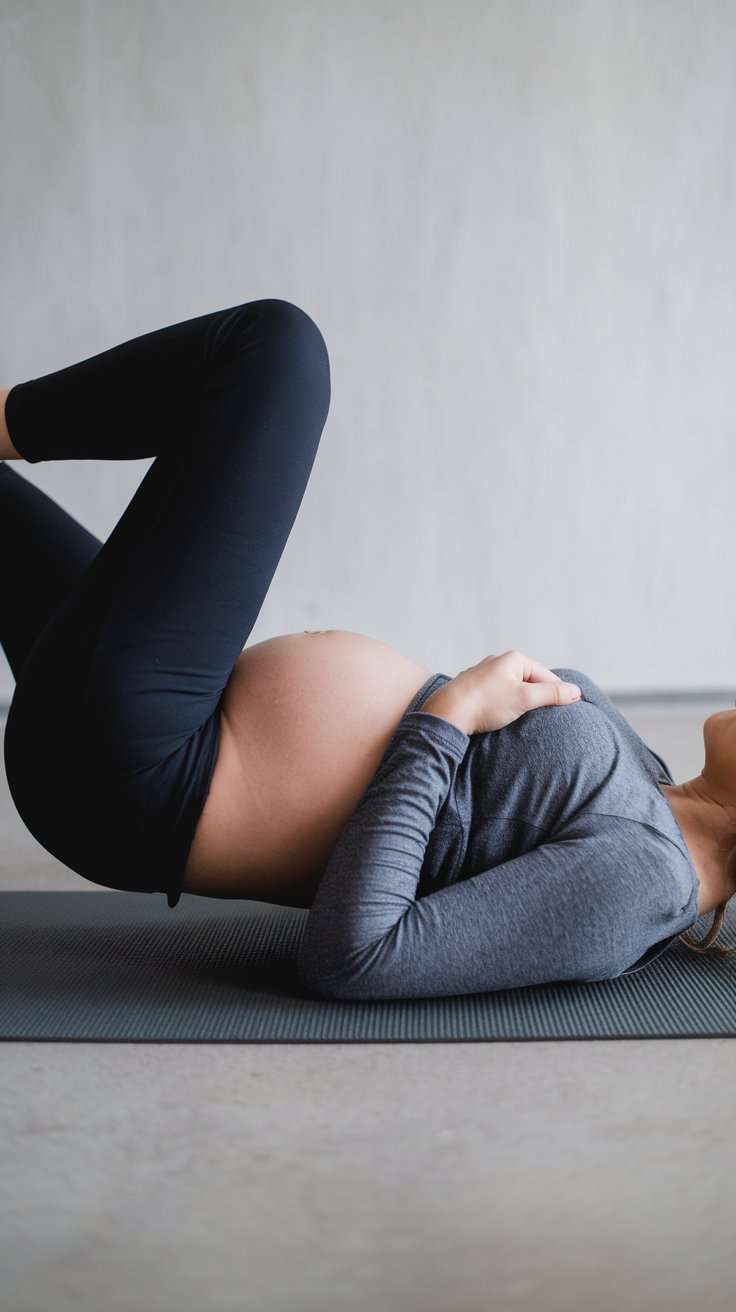Maintaining a healthy lifestyle during pregnancy is crucial for both mother and baby and incorporating safe abdominal exercises during pregnancy can play a significant role. Exercises for the abdomen assist a growing tummy, strengthen the core, and ease back pain.
However, in order to protect your safety and the welfare of your unborn child, it is imperative that you select exercises that are acceptable for each trimester. With the best 5 safe stomach workouts for each trimester outlined in this blog post, you’ll have a comprehensive plan for staying comfortable and fit throughout your pregnancy.
First Trimester Exercises:
During the first trimester, your body is just beginning to adjust to the changes of pregnancy, so it’s crucial to focus on safe abdominal exercises during pregnancy. Two excellent exercises to start with are Modified Crunches and Pelvic Tilts.

Exercise 1: Modified Crunches A mild method of strengthening your core without overly straining your abdomen is to perform modified crunches. Laying on your back with your knees bent and your feet flat on the floor is how you perform Modified Crunches.
Keeping your lower back firmly against the floor, slowly raise your upper torso off the ground with your hands behind your head for support. Steer clear of high lifts and forceful movements, and concentrate on deliberate, fluid motions. With minimal pressure, this exercise helps to strengthen the abdominal muscles.
Exercise 2: Pelvic Tilts Pelvic Tilts are another effective exercise that can help relieve lower back pain and strengthen your core. Start by lying flat on your back with your feet flat and your knees bent. Tilt your pelvis upwards, pressing your lower back into the floor, then relax and return to the starting position.
Perform this exercise slowly and with controlled movements. Pelvic Tilts not only strengthen your abdominal muscles but also improve flexibility and reduce discomfort as your pregnancy progresses.
These exercises are ideal for the first trimester as they are gentle on your body while providing effective core strengthening.
Second Trimester Exercises:
As you transition into the second trimester, your body is experiencing more significant changes, and it’s important to focus on safe abdominal exercises during pregnancy that accommodate your growing belly. Two beneficial exercises for this stage are Seated Side Crunches and the Cat-Cow Stretch.

Exercise 3: Seated Side Crunches Seated Side Crunches target the oblique muscles, which help support your expanding belly. To perform this exercise, sit on a chair or the edge of a stable surface with your feet flat on the ground and your back straight. Place your hands behind your head or on your hips for balance.
Gently lean to one side, bringing your elbow towards your hip, and then return to the starting position. Alternate sides for a set of repetitions. This exercise helps to strengthen the side muscles of your abdomen, improving core stability while being mindful of your growing bump.
Exercise 4: Cat-Cow Stretch The Cat-Cow Stretch is a great way to keep your back pain from getting worse during the second trimester and to preserve your flexibility. Starting from the hands and knees position, place your wrists beneath your shoulders and your knees beneath your hips.
Taking a deep breath, raise your head and tailbone toward the ceiling by arching your back (Cow Pose). Breathe out, round your back, draw your belly button into your spine, and tuck your chin into your chest (cat pose).
Slowly and carefully alternate between these two positions. This stretch releases tension in the back and increases spine flexibility in addition to activating your abdominal muscles.
Both exercises are designed to support your body’s needs during the second trimester while ensuring safe abdominal exercises during pregnancy.
Third Trimester Exercises:
In the third trimester, comfort and safety become paramount as your body adjusts to the final stages of pregnancy. It’s essential to choose safe abdominal exercises during pregnancy that accommodate your growing belly and reduce strain. One effective exercise for this period is the Side-Lying Abduction.

Exercise 5: Side-Lying Kidnappings As your pregnancy goes on, side-lying abductions are a great technique to develop your hip and outer thigh muscles, which will support your pelvis and lower back. Lay on your side with your legs extended and your head propped up on your arm or a pillow to complete this exercise.
Lift your upper leg slowly toward the ceiling while maintaining your lower leg bent for stability. Lift it only as high as is comfortable, then carefully drop it back down. After a certain number of repetitions, switch sides.
You can benefit from improved overall stability and balance when your center of gravity shifts with this workout.
Additionally, it supports core strength without placing undue stress on your abdomen, making it one of the safe abdominal exercises during pregnancy suitable for the third trimester.
Incorporating Side-Lying Abductions into your routine can aid in maintaining muscle strength and enhancing comfort during this final stage of pregnancy.
Safety Considerations:
When engaging in safe abdominal exercises during pregnancy, it’s crucial to prioritize safety to ensure both your well-being and that of your baby. The following are important things to remember:
Consult Your Healthcare Provider: Before starting any exercise routine, including abdominal exercises, consult with your healthcare provider. They can provide personalized recommendations based on your health and pregnancy progression.
- Avoid Exercises on Your Back: In the later stages of pregnancy, lying flat on your back can put pressure on your vena cava, reducing blood flow. Opt for exercises that can be performed in a seated or side-lying position to avoid this issue.
- Listen to Your Body: Pay attention to how your body responds to each exercise. If you experience discomfort, dizziness, or any unusual symptoms, stop immediately and consult your healthcare provider.
- Focus on Gentle Movements: Choose exercises that are low-impact and avoid any that involve jerky or high-intensity movements. Gentle, controlled exercises are safer and more effective in supporting your core and overall stability.
- Stay Hydrated and Avoid Overheating: Ensure you drink plenty of water and exercise in a cool, well-ventilated area to avoid overheating, which can be harmful during pregnancy.
By adhering to these safety considerations, you can ensure that your routine of safe abdominal exercises during pregnancy is both beneficial and secure throughout your pregnancy journey.
Conclusion:
Incorporating safe abdominal exercises during pregnancy is crucial for maintaining core strength, stability, and overall comfort as your body changes. By following the guidelines and selecting exercises appropriate for each trimester, you can enhance your well-being and support your growing baby effectively.
Always prioritize safety, listen to your body, and consult with your healthcare provider to ensure that your exercise routine remains beneficial and secure throughout your pregnancy journey. Stay active and healthy for a smoother, more comfortable pregnancy.
FAQs:
Can I do abdominal exercises during the first trimester?
Yes, gentle exercises like Modified Crunches and Pelvic Tilts are generally safe. Always consult your healthcare provider before starting any new exercise routine.
Are there specific abdominal exercises to avoid in the third trimester?
Avoid exercises that require lying flat on your back or involve intense twisting movements. Opt for safe options like Side-Lying Abductions instead.
How often should I do safe abdominal exercises during pregnancy?
Aim for 2-3 times per week, ensuring that you listen to your body and adjust as needed for comfort and safety.
What are the benefits of safe abdominal exercises during pregnancy?
These exercises can improve core strength, alleviate back pain, and enhance overall stability, making it easier to handle the physical changes of pregnancy.
When should I stop doing abdominal exercises during pregnancy?
Stop if you experience discomfort, pain, or unusual symptoms. Always consult with your healthcare provider if you have concerns about continuing your exercise routine.
